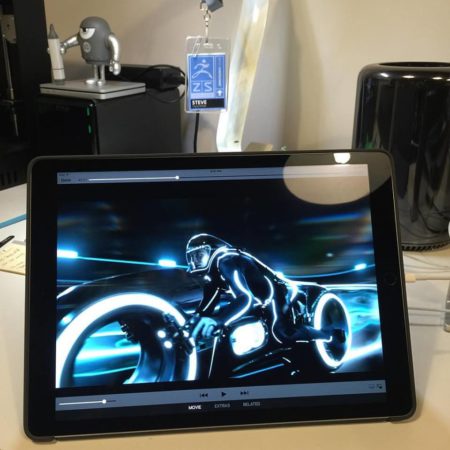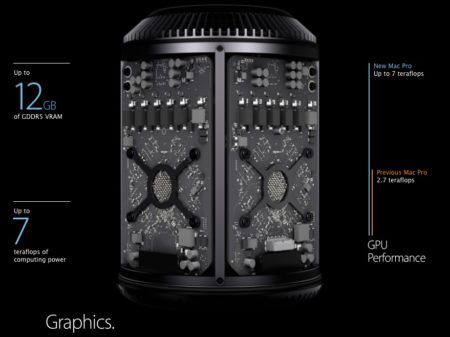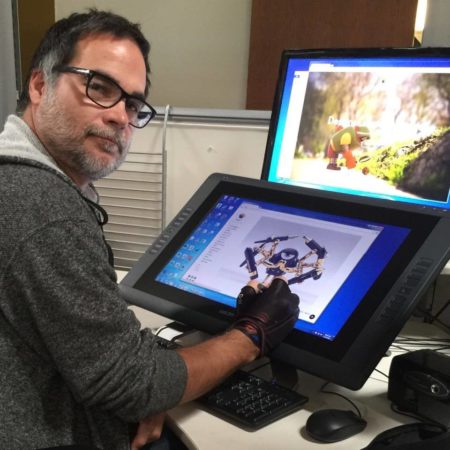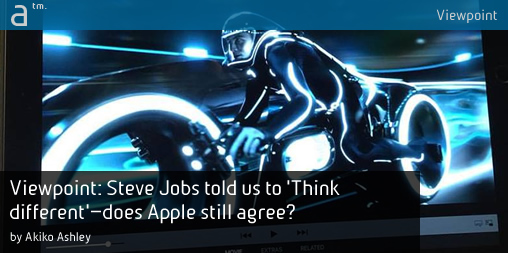Apple is a unique tech company that has been making hardware and software since April 1, 1976. In the commercial “1984” by Ridley Scott, Apple introduced its iconic product the Macintosh.
Apple’s vision—led by Steve Jobs—would innovate the desktop computer and later the mobile market. Apple was one of the first to use a GUI (graphical user interface), the mouse and a CD-ROM drive. Seamless hardware and software integration made Macs reliable, consistent, tough workhorses. Graphics artists, musicians, scientists, architects, and many other visionaries loved their Macs.
When Steve Jobs passed away in 2011 the world lost a visionary leader. Apple’s roadmap for their hardware shifted development from desktop to mobile. Apple’s shift was first detected in the delay of the updated Mac Pro and eventual new Mac Pro design, in addition to dropped pro apps Shake, Aperture, and other Pro products.
MORE: The Mac Pro: So what’s a D300, D500 and D700 anyway? We have answers
Apple not only controls the hardware and OS’s (operating systems) but also has leading-edge content platforms in its ‘App Store’, ‘iTunes’, and now Apple Music. Despite all these wonderful technologies, they are primarily for consumers not Pros. The new Mac Pro met with mediocre applause. It sacrificed internal expandability for a smaller footprint. What was the intent of this design?
So in 2015, Apple introduced…the iPad Pro. This new device for professional users gives them traditional drawing tools with Apple Pencil and a keyboard. The bigger screen gives more real estate for drawing and using apps. Is this the replacement for desktop computing?

01 – Sketchbook Studio’s Steve Talkowski’s iPad Pro & Mac Pro on his desk. (Image Courtesy of Steve Talkowski) All rights reserved.
Will this be the end of the PC? Let’s just say that desktop sales are dropping, but PC manufacturers are indeed finding new markets for their hardware—selling servers, storage, and switches in data centers that support cloud computing, and processing power for high intensive applications. It is this hardware that is running Siri, iCloud, and Apple’s other data intensive needs. As the need grows for high-end servers, storage, and switches, this will be the growth for the PC market that supports the end user mobile market. Is Apple’s new iPad Pro the beginning of a new era for professionals…developed in the wake of the PC’s decline?
iPad Pro’s Introduction
Apple recently released the iPad Pro with a 12.9 inch screen with support for the Apple Pencil and a keyboard. Apple claims that the processor is faster than 80 percent of portable PCs out there, and the graphics faster than 90 percent of all portable PCs in the marketplace. (per ZDnet.com).
Tim Cook hopes that iPad Pro will be a product that is adopted by the Enterprise market and migrate creative pros to a tablet. The Enterprise market will be a new challenge for Apple; Apple will need to train internal IT people to support the tablet to increase its chance of adoptability. Mark Hibben reported in SeekingAlpha.com that iPad sales have dropped 23% in 2015 while Microsoft Surface was able to claim growth of 117%, yet iPads outsell Surface tablets 5-to-1.

02 – 20+ year veteran in computer animation Steve Talkowski of Sketchbot Studios developing a robot animated series using his iPad. (Image courtesy of Steve Talkowski.) All rights revered.
Slice reported that Apple’s iPad Pro sales have been sluggish out the gate, yet early indications from Architosh readers are that architects are anxious to get their hands on it. (more in future report).
- Sales of the iPad Pro were 70% less than the iPad Air 2 and the iPad Mini 3
- 85% of the sales of the iPad Pro were for the 128 GB model
- 86% were bought online
- 51% bought Apple Pencil (not available yet)
- 41% bought the Apple Keyboard
- 58% chose Space Gray, Gold 24%, Silver 18%
Apple’s tablet future will be highly dependent on Apple supporting it with third party wireless tech to give it expandability like its PC counterpart, and supporting developers in a wide net of disciplines.
Apple Shipping Electric Car in 2019
Wallstreet Journal reported in September of 2015 that Apple will be shipping an Electric Car in 2019.
- Combined worldwide sales of hybrid and plug-in electric vehicles will reach 6.6 million annual units by 2020 and become almost 7% of the total light-duty vehicle market, according to Navigant Research’s 2013-2020 Electric Vehicle Market Forecast. (as per cleantechnica.com)
- Nissan leads the Plug In Electric Vehicle sales with 30,200 units in 2014.
- As of August 2015, Tesla installed over 500 Supercharging Stations around the world.
When Apple enters this market space it will enter behind many automotive companies that already have infrastructure in place. Porsche and BMW being two of those players. Tesla being the most famous brand of electric cars with its visionary leader Elon Musk as one of the innovators of the space.
How will Apple support this car? What infrastructure will be in place and who will maintain this vehicle? Does it make sense to make the consumer level car like the Leaf or the high end innovative luxury car like the Tesla?
Apple’s strengths are its design, tech and brand. How will this effect its success in the automotive market?
Apple Creating Wearable Tech
Apple introduced its new wearable tech with the Apple Watch in September of 2014.WSJ.D on August 2015 said that IDC reported that Apple sold 3.6 million watches in their second quarter.
- WSJ.D on August 2015 said that IDC reported that Apple sold 3.6 million watched in their second quarter.
- WSJ.D further states that IDC said Apple’s sales placed it second among sellers of wearable devices, behind Fitbit, Inc.
Will the Apple Watch market grow? Will Apple consider selling the Apple Watch through retailers in the fashion industry to expand its sales?
Apple TV as a Casual Game platform & Apple as a Production Company.
In September 2015 the new Apple TV was introduced using the A8 chip that is found in the iPhone 6 and iPhone 6 Plus (an upgrade from the single core A5 chip running in current model) with iOS 9 at its core. It does lack support for 4K video streaming. Apple hopes it will be the new set top box that replaces the Nintendo Wii for casual gaming in the living room with it’s new motion control sensor with the ease of purchase with the App store. Apple does restrict certain content in its ‘App Store’ so this may inhibit some developers from developing games for this device.
Variety Magazine reported in August 2015 that Apple was exploring the idea of producing original programming for Apple TV. Though this would be a great idea to help it compete with Amazon, Hulu and Netflix, which can be accessed on many tech devices, it is not a groundbreaking announcement. How will Apple accomplish this? Will they just invest money into certain projects or will they form their own studio? Does a subscription service make sense similar to Apple Music? Tim Cook has $200 billion at his disposal to invest in such an endeavor. Apple has been quietly distributing movies it grabs at film festivals for iTunes. We will have to wait and see where this goes.
Apple Music
Apple has always been loved my musicians and people who listen to music.
- According to Fortune, Apple snagged 11 million trial users of Apple Music, though this is a good start
- Spotify ranks number one with over 20 million users
- Fortune also states that there are only 41 million paid subscribers of music services, which means Apple got the attention of one quarter of the market.
Will Apple Music be able to grow the music subscription market itself? What market share will Apple ultimately hope to have?
Why Mac Pro is important to Apple.
The IBM PowerPC G5 CPU was officially announced during Steve Jobs’ keynote at the 2003 Apple Worldwide Developers Conference (WWDC 2003). It went through three updates before being retired in 2006. Apple went from the G5 chip to the Intel chip changing the product line renaming it Mac Pro. In 2008, the first Mac Pro was introduced with the same enclosure as the G5.
-

03 – Apple’s Mac Pro features D300, D500 and D700 dual FirePro GPUs that roughly equal W7000, W8000 and W9000 existent graphics cards. They are Pitcairn and Tahiti-based GCN Architecture units offering stunning power and range. Despite that power, the new Mac Pro has been controversial within the markets it traditionally serves.
- It is the second generation Mac Pro update (often called nMP) with the enclosed black cylinder tower that baffled some Pro users. (see image 03 above). It runs on a Xeon E5 chip that can either be quad, six or eight cores. Xeon’s can handle extensive workloads better then the i5 or i7 line of chips, and that’s really critical for some kinds of Pro users.
What really upset certain Pros was that Apple chose the AMD FirePro line of cards for the graphics card that required a proprietary design. This proprietary design limited third party development of graphics cards since third party developers need volume sales to create new card formats. Limited expandability made it tough for Pros who loved the small footprint but had to plug in several devices to the box to make it work. Pros need expansion to add features unavailable in the core machine. It is these Creative Pros who create music, movies, architecture and art that became part of Apple’s legendary marketing angle. If Apple gets into producing content, won’t they need a powerful Mac Pro to be part of the development and pipeline?
Can we still Think different?
The Cult of Mac writer John Brownlee wrote an article in January of 2014 whose title was “The Hardware That Siri Runs On Puts The New Mac Pro To Shame.” The article says that Siri runs on 32 HP servers, a total of 1024 cores and 32 terabytes of RAM a piece. Why doesn’t the Apple Mac Pro compete in this market?
The new Mac Pro is being embraced by graphics professionals with low intensity demands. Architects, graphic artists, and musicians are adopting it in some measure, but not like they adopted the older G5-Intel era Mac Pro. 3D animation and VFX professionals, along with video game development need expandability with hardcore GPU power that the new Mac Pro simply doesn’t provide.

04 – 20 year computer animation veteran from Skethbot Studios, creating self produced designer toys is doing a sketch of Sketchbot on Mac Pro. (Image courtesy of Steve Talkowski) All rights reserved.
Apple should consider that the Mac Pro is one of the products that helped Apple capture the hearts and minds of many of its loyal customers in architecture, music, film and advertising graphic arts. Steve Jobs once told us to Think different. The Mac Pro is one of the products that allowed professionals to do just that.
MORE: Viewpoint: How Apple’s iPad Pro and devices like it will change Architecture
Unlike the mobile products, this is a product that allowed customization to the users’ needs; and it allowed the power user to bring their imagination to life. While Tim Cook has high hopes for the iPad Pro with Apple Pencil, it is still difficult to create content on the mobile platforms—everyone’s—especially at the Hollywood level. Mac Pro is for the content creators and the mobile products for content consumption. Unity games are are developed on a Mac and then exported to a mobile device.




Reader Comments
https://t.co/VFpWC8ceHL — Steve Jobs told us to “Think different”…in the era of mass markets, does Apple believe? https://t.co/ZHujfYkfpD
https://t.co/VFpWC8ceHL — Steve Jobs told us to “Think different”…in the era of mass markets, does Apple believe? https://t.co/ZHujfYkfpD
There is a much greater diversity of devices on the Windows side. Apple’s popularity among creatives is now mostly based on nostalgia and mythology.
There is a much greater diversity of devices on the Windows side. Apple’s popularity among creatives is now mostly based on nostalgia and mythology.
Comments are closed.